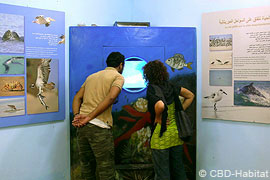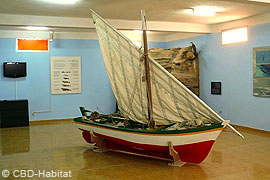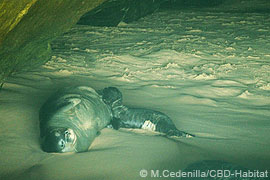Italy
GFM in Greece and Croatia
A monk seal sighted near Lefkada.
During a July excursion to Greece coordinated by Luigi Guarrera, several members of GFM (Gruppo Foca Monaca), visited the Ionian island of Kefalonia and there met with monk seal researcher Aliki Panou of the NGO Archipelagos. Together, they visited several points on the island, both on land and at sea, appreciating the fact that, in spite of the high-summer tourism pressure, the large island still maintains various habitat areas suitable for the seals.
One seal was observed on the eastern part of the island, together with several swimming sea turtles (Caretta caretta). Possible cooperation and support activities between GFM and Archipelagos were discussed.
Cooperation with the Croatian NGO Mediterranean Monk Seal Group (Grupa Sredozemna Medvjedica) also continued, following a spate of recent monk seal observations in the Adriatic. At the same time, GFM received several reports of seal sightings from Greece (3 were of seals around Lefkada); from northern Cyprus; and from Croatia (close to the Kornati islands), most accompanied by photographic evidence and related descriptions. GFM’s public awareness activity through the media has also continued, with an article on monk seals published in the October supplement “Viaggi” (Travelling) of the important Italian newspaper “La Repubblica”. – Luigi Guarrera, GFM.
Madeira
Aiming for higher public participation in monk seal monitoring...
Bringing maritime authorities, beach guards and others into the monk seal monitoring process.
The Mediterranean monk seal population in the Madeira Archipelago is gradually recovering, and dispersing from the outlying Desertas Islands towards the main island of Madeira, in search of new habitat.
Madeira’s human inhabitants and the maritime authorities play a key role in providing information on the species, particularly on population numbers and distribution. Consequently, the monk seal population was the object of a more intense public awareness campaign around the island of Madeira between May and October 2008.
The number of monk seal sightings is significantly higher in fishing and recreational areas, where the most common activities are swimming, surfing, windsurfing, diving, sailing and canoeing, increasing the probability of observation. As a result, the sensitisation campaign was directed at these areas, under the slogan, “What should you do when sighting a monk seal?” Public awareness materials, such as books, posters and monk seal sighting observation forms were also distributed.
In order to encourage greater involvement of the maritime authorities in monk seal monitoring, the Service of the Parque Natural da Madeira held several explanatory sessions for the Madeira maritime police, the National Republican Guard and the beach Life Guards. The objective was to inform personnel about what steps they should take when encountering a monk seal, what should be recorded during the observation, and what action should be taken if the seal is sick, wounded or dead.
Feedback from the campaign was very positive. Not only did reports of monk seal observations increase in Madeira, but also the information was more accurate, a decisive factor in improving our knowledge about population dynamics. The feedback also provides baseline data for future monitoring and management of potential interactions between Mediterranean monk seals and human activities, whilst promoting Mediterranean monk seal conservation through the public dissemination of the results. – Rosa Pires and Carolina Santos, Parque Natural da Madeira.
Challenge: “Create a monk seal toy”
Prize-giving at the Santa Cruz toy exhibition.
The challenge was posed to the pupils of middle schools in Madeira in an island-wide competition: create a monk seal toy.
Children 10-15 years old participated in the contest, building 19 toys of various type and design. All the toys were later exhibited at the Culture House in Santa Cruz in May, along with information on the species itself. – Rosa Pires and Carolina Santos, Parque Natural da Madeira.
Spreading the word about monk seal and whale conservation in Madeira…
Children from Machico and surrounding areas with Tim Lewis, Song of the Whale scientist.
Two exciting events were recently held in Madeira to highlight monk seal and whale conservation on the island. Parque Natural da Madeira and the Madeira Whale Museum teamed up with the International Fund for Animal Welfare’s team from research vessel Song of the Whale to hold two days of activities and events in both Funchal and Machico. Local children were invited onboard the boat – over 200 in total – to learn about monk seal and whale conservation.
Also, two VIP events were held that were well attended by representatives from government, education and local NGOs. Local TV, radio and print journalists were invited to attend a press day on the boat, and coverage of the issues was achieved in all three mediums. Rosa Pires, Biologist and Monk Seal Co-ordinator from Parque Natural da Madeira said: “We have been delighted to partner with IFAW and the Madeira Whale Museum to put on these events. It has been a great opportunity to highlight the work that we are doing here on Madeira both for monk seals and for whales and we look forward to more joint working in the future.”
IFAW representatives Lesley O’Donnell and Hemmo Muntingh also attended the events. – Bridget Jones, Song of the Whale Research Team, IFAW.
Mauritania & Western Sahara
Lactation on an open beach in Cabo Blanco: first known record since 1945
Since the creation of the ‘Coast of the Seals’ marine-terrestrial reserve in 2001, observations of animals using open beaches has increased progressively. This phenomenon was particularly evident last year, when groups of seals and even juveniles and pups were observed hauling out on an open beach close to one of the breeding caves.
Even though this was a great achievement in itself, we could not even imagine that the next step forward would come so soon. This October, however, we observed a mother rearing her pup on an open beach called ‘playa del Halcón’. The pup had been born in a nearby breeding cave, but moved to the beach with its mother when it was 1 month old. After several days, we saw the mother vocalising, coming and going from the beach where animals have been observed hauling out since last year. A few minutes later, at the southern beach, we observed the encounter between the pup and its mother. They moved out of the reach of the waves and, no more than five minutes later, the pup began suckling from its mother.
This is the first time that lactation at an open beach has been reported since Morales Agacino described it in 1945, over 60 years ago. The pup continued to be reared by its mother, a well-known breeding female 14 years of age, and even moulted in its new habitat. This development makes us very optimistic about the progressive recolonization of open beaches, no longer just for hauling out, but also for breeding. – Mercedes Muñoz and Pablo Fernández de Larrinoa, Fundación CBD-Habitat.
Cabo Blanco annual pup production
To date, the birth of 43 pups has been recorded during 2008 at the Cabo Blanco colony breeding caves. With the breeding season not yet closed, however, further births are expected, especially since several pregnant females have been observed in the caves area. The monitoring of the births has proved harder this year than in previous years, because a new cave has been used by seals to haul out and give birth. The absence of a video-monitoring camera in this cave and the fact that only a part of its inner beach is visible from the entrance, has prevented a complete monitoring of the birth period. As a matter of fact, a minimum number of 4 pups have been born in this cave, and groups of at least 27 seals have been observed inside.
Up until today, the monitoring team has been able to identify 80% of the breeding females that gave birth during this year, and even though some pups have not yet reached moulting age, we can say that the provisional pup mortality rate is low, around 25%. We hope to be able to report in the next issue of The Monachus Guardian that the productivity for the whole year has increased in respect to previous ones, and that mortality rates have remained low. – Miguel Angel Cedenilla and Moulaye O. Haye, Fundación CBD-Habitat.
Visitors centre ‘Le Phoque Moine’ open to the public
The first visitors centre in a protected area in the whole of West Africa has recently been opened to the public in the Satellite Reserve of Cap Blanc (National Park of Banc D’Arguin) and, as to be expected, it is devoted to the marine environment and the Mediterranean monk seal. The ‘Phoque Moine’ centre was built as part of a project executed by CBD-Habitat Foundation and the National Park of Banc D’Arguin, and funded by the International Spanish Cooperation Agency and the National Parks of Spain, with the participation of UNESCO.
 |
|
 |
|
|
|
|
The centre holds a permanent exhibition with panel displays, a life-size adult male monk seal and a video documentary about the species in Cabo Blanco. A nature trail around the reserve has also been marked-out, guided with informative panels so that visitors can discover the area’s natural wealth and diversity. The centre is visited by people from the nearby city of Nouadhibou, and mainly students, since several activities are being developed with primary and secondary schools. – Ana Maroto and Hamdi M’Barek, Fundación CBD-Habitat.
|






